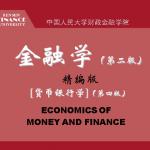考试题型以及分数分布:
一、 选择题:1’*20=20’
二、 名词解释:4’*5=20’
三、 简答题:8’*5=40’
四、 论述题:20’*1=20’
重点制作思路:
1.考虑到时间关系,抓大放小
2.结合老师提及复习内容进行预测
3.以理顺书本架构为主,看到一个知识点猜一下可能会出什么题
The economics of money,banking and financial markets----by Kyle
Chapter1:Why Study Money, Banking, and Financial Markets?
(本章了解一下这个问题即可,最多考一下选择)
Answer:
l To examine how financial markets such as bond and stock markets work
l To examine how financial institutions such as banks work
l To examine the role of money in the economy
Chapter2:An Overview of the Financial System
1. Function of Financial Markets
l Perform the essential function of channeling funds from economic players that have saved surplus funds to those that have a shortage of funds
l Direct finance: borrowers borrow funds directly from lenders in financial markets by selling them securities.
l Promotes economic efficiency by producing an efficient allocation(分配) of capital(资金), which increases production
l Directly improve the well-being of consumers by allowing them to time purchases better
2.Structure of Financial Markets
l Debt and Equity (普通股) Markets
l Primary and Secondary Markets
l Exchanges and Over-the-Counter (OTC不通过交易所而直接售给顾客的) Markets
l Money and Capital Markets(货币和资本市场)
3. Financial Market Instruments(要能举出例子,很可能考选择)
Money markets deal in short-term debt instruments
Capital markets deal in longer-term debt and equity instruments.
4.Internationalization of Financial Markets(重点,选择、名词解释都有可能)
l Foreign Bonds & Eurobond?
l Eurocurrencies & Eurodollars?
l World Stock Markets
5.Function of Financial Intermediaries: Indirect Finance
(记一下金融中介机构的功能,交易成本很可能考名词解释)
l Lower transaction costs (time and money spent in carrying out financial transactions).
l Reduce the exposure of investors to risk
l Deal with asymmetric 不对称 information problems
l Conclusion:
Financial intermediaries allow “small” savers and borrowers to benefit from the existence of financial markets.
6. Types of Financial Intermediaries(会分类即可)
Depository institutions
Contractual saving institutions
Investment intermediaries
7. Regulation of the Financial System
l To increase the information available to investors:
l To ensure the soundness 健康稳固of financial intermediaries
Chapter3:What Is Money?
1. Meaning of Money(即definition,必考名词解释!!)
l Money (or the “money supply”): anything that is generally accepted in payment for goods or services or in the repayment of debts.
2. Functions of Money(重点)
l Medium of Exchange:
l A medium of exchange must
l Unit of Account:
l Store 储藏 of Value:
3. Evolution of the Payments System
l Commodity 商品 Money
l Fiat 法定 Money
l Checks 支票Electronic Payment (e.g. online bill pay).
l E-Money (electronic money):
4. Measuring Money (重中之重,M1/M2都很有可能考名词解释)
l Construct monetary aggregates using the concept of liquidity:
(构建货币总量使用流动性的概念)
l M1 (most liquid assets) = currency + traveler’s checks + demand deposits + other checkable deposits.
l M2 (adds to M1 other assets that are not so liquid) = M1 + small denomination time deposits + savings deposits and money market deposit accounts + money market mutual fund shares.
Chapter 4:Understanding Interest Rates
1. measuring interest rates:Present Value(很可能考察名词解释)
A dollar paid to you one year from now is less valuable than a dollar paid to you today
Simple Present Value:PV=CF/(1+i)n次方
2. Four Types of Credit Market Instruments
l Simple Loan
l Fixed Payment Loan
l Coupon Bond 附票债券
l Discount Bond 贴现债券
3.Yield to Maturity(重点,很可能名词解释)
l The interest rate that equates the present value of cash flow payments received from a debt instrument with its value today
计算4种不同信用工具外加Consol or Perpetuity(金边债券或永久债券)的YM
4. Yield on a Discount Basis(了解即可)
Current Yield当期收益率
Yield on a Discount Basis 折价收益率
Rate of Return 收益率
5.Rate of Return and Interest Rates(收益率与利息率的distinction)
l The return equals the yield to maturity only if the holding period equals the time to maturity
l A rise in interest rates is associated with a fall in bond prices, resulting in a capital loss if time to maturity is longer than the holding period
l The more distant a bond’s maturity, the greater the size of the percentage price change associated with an interest-rate change
l The more distant a bond’s maturity, the lower the rate of return the occurs as a result of an increase in the interest rate
l Even if a bond has a substantial initial interest rate, its return can be negative if interest rates rise
6. Interest-Rate Risk
l Prices and returns for long-term bonds are more volatile than those for shorter-term bonds
l There is no interest-rate risk for any bond whose time to maturity matches the holding period
7. Real and Nominal Interest Rates(重点,很可能考察简答题)
l Nominal interest rate makes no allowance for inflation
l Real interest rate is adjusted for changes in price level so it more accurately reflects the cost of borrowing
l Ex ante real interest rate is adjusted for expected changes in the price level
l Ex post real interest rate is adjusted for actual changes in the price level
8. Fisher Equation(重点考察)
Chapter5:The Behavior of Interest Rates
1. Determining the Quantity Demanded of an Asset
l Wealth: the total resources owned by the individual, including all assets
l Expected Return: the return expected over the next period on one asset relative to alternative assets
l Risk: the degree of uncertainty associated with the return on one asset relative to alternative assets
l Liquidity: the ease and speed with which an asset can be turned into cash relative to alternative assets(流动性很有可能考名词解释)
2.Theory of Asset Demand(必考,死活都得背下来)
Holding all other factors constant:
1. The quantity demanded of an asset is positively related to wealth
2. The quantity demanded of an asset is positively related to its expected return relative to alternative assets
3. The quantity demanded of an asset is negatively related to the risk of its returns relative to alternative assets
4. The quantity demanded of an asset is positively related to its liquidity relative to alternative assets
3. Supply and Demand for Bonds(见到看一下图)
Market Equilibrium
4. Shifts in the Demand for Bonds
l Wealth: in an expansion with growing wealth, the demand curve for bonds shifts to the right
l Expected Returns: higher expected interest rates in the future lower the expected return for long-term bonds, shifting the demand curve to the left
l Expected Inflation: an increase in the expected rate of inflations lowers the expected return for bonds, causing the demand curve to shift to the left
l Risk: an increase in the riskiness of bonds causes the demand curve to shift to the left
l Liquidity: increased liquidity of bonds results in the demand curve shifting right
5.Shifts in the Supply of Bonds
广外 货币银行学期末重点 全英 米什金
本站小编 免费考研网/2020-01-01
相关话题/货币银行学
金融硕士考研货币银行学复习方法
一、货币银行学框架货币银行学这门学科按字面的意思分为货币和银行两部分。现代的经济是货币经济,也就是说生产、分配、交换、消费必须依靠货币来进行。货币是基于人们对货币发行当局的信任而存在的,货币的出现为复杂的资源分配提供了一个简单的机制,即价格机制,通过价格决定每个人应该得到什么,应该生产什么,从而达到 ...金融硕士经验 本站小编 免费考研网 2019-12-12黄达金融学PPT课件精编版 货币银行学 第四版
 .. ...专业课考研资料 本站小编 免费考研网 2019-04-10
.. ...专业课考研资料 本站小编 免费考研网 2019-04-10四川大学货币银行学笔记
《货币银行学》概念缩略【川大版】 货币职能:交易职能、价值标准、延期支付、价值贮藏。 货币种类:实物货币(作为交易媒介的货币与商品价值量相等的货币)、信用货币(其本身 价值不与商品价值相等,但是其不能代表任何商品价值的货币)。 实物货币种类:实体货币、代表实物货币或者代用货币。前者是指,作为交易媒介 ...专业课考研资料 本站小编 免费考研网 2019-04-07对外经贸大学货币银行学作业、习题及答案
一、作业与习题 第一章 货币与货币制度 【作业与练习】 1. 基本概念:价值尺度 流通手段 支付手段 贮藏手段 铸币 信用货币 纸币 银行券 本位币 无限法偿 有限法偿 准货币 2. 试述货币的定义。 3. 比较货币职能的不同表述。 4. 试论货币在当代发达的市场经济条件下的作用。 5. 试述货币制度的基本构成要素。 6. ...专业课考研资料 本站小编 免费考研网 2019-04-05对外经贸大学货币银行学笔记
对外经贸大学货币银行学笔记 第一章货币的起源、本质和职能 一、 起源 货币产生于商品交换发展 为什么商品交换发展必定会产生货币 ①作为商品,具有使用价值和价值,两者密切结合,系于商品本身直接物物交换的特点。 ②货币的产生解决了直接物物交换的困难,整个商品流通由货币组成了一个链条。 不能解决私有 ...专业课考研资料 本站小编 免费考研网 2019-03-28西南财经大学货币银行学笔记
货币银行学笔记货币银行学:①含义;②研究的核心货币;③货币银行学的局限性:没能很好地把货币银行与金融市场联系起来。 货币与货币制度问题:(1)、是否作为交换媒介的商品就是货币?为什么?(是的,货币的演进)。(2)、货币是一般等价物,其内涵是什么?(货币是商品,有价值,商品充当交易媒介) ...专业课考研资料 本站小编 免费考研网 2019-03-27货币银行学学习笔记
《货币银行学》学习笔记 一、货币 1.信用货币、电子货币、0M、1M、2M、准货币 信用货币是货币的较高发展形式,它是指作为货币的价值大于其作为商品的价值的货币。它替代金属货币,在商品经济中充当流通手段和支付手段。①货币执行流通手段职能时,只在买卖瞬间起作用,人们只关心其购买力,并不关心货币本身有无价值,所以 ...专业课考研资料 本站小编 免费考研网 2019-03-25四川大学货币银行学考研复习笔记
《货币银行学》概念缩略【川大版】 货币职能:交易职能、价值标准、延期支付、价值贮藏。 货币种类:实物货币(作为交易媒介的货币与商品价值量相等的货币)、信用货币(其本身价值不与商品价值相等,但是其不能代表任何商品价值的货币)。 实物货币种类:实体货币、代表实物货币或者代用货币。前者是指,作为交易媒介 ...专业课考研资料 本站小编 免费考研网 2019-03-17金融-备考笔记-货币银行学-胡庆康
金融联考备考笔记-货币银行学 之三:货币银行学 注意:下文提及的结构与图表来自复旦出版社出版的《货币银行学》胡庆康编写 这本书是指定参考书 货币银行学和国际金融学不同于西方经济学,总的来说难度要小的多,没有复杂的模型和数学推导,而且其考试的特点是只会出现名词解释、计算题(简单的套公式和加减乘除)、 ...专业课考研资料 本站小编 免费考研网 2019-03-172018西北师范大学货币银行学考研金融复试复习题答案
 货币与货币制度 一、填空 1、从货币本质出发,货币是固定充当(一般等价物)的特殊商品;从价值规律的角度看,货币是核算(一般等价物)的工具。 2、古今中外很多思想家和经济学家都看到了货币的起源与(交换发展)的联系。 3、银行券是随 ...专业课考研资料 本站小编 免费考研网 2018-03-29
货币与货币制度 一、填空 1、从货币本质出发,货币是固定充当(一般等价物)的特殊商品;从价值规律的角度看,货币是核算(一般等价物)的工具。 2、古今中外很多思想家和经济学家都看到了货币的起源与(交换发展)的联系。 3、银行券是随 ...专业课考研资料 本站小编 免费考研网 2018-03-29西南大学2006年考研真题-货币银行学
专业课考研经验 本站小编 FreeKaoyan 2018-01-23河北大学2005年考研真题-货币银行学
专业课考研经验 本站小编 FreeKaoyan 2018-01-23中国人民银行研究生部2000年考研真题-货币银行学综合
一、简答题(每题5分,共50分)1.特别提款权2.自然失业率3.普惠制4.互助基金(MUTUALFUND)5.税收的特征6.完全市场竞争7.要约与要约邀请8.保险价值与保险金额9.二板市场10.国内生产总值平减指数与消费物价指数 二、简述题(每题10分,共50分)1.影响需求弹性的因素有哪些?2. ...专业课考研经验 本站小编 FreeKaoyan 2018-01-22中国人民银行研究生部2001年考研真题-货币银行学综合
一、简答题(每题5分,共50分): 1、效用 2、局部均衡和一般均衡 3、购买力平价 4、替代与互补 5、财政的经济职能 6、再保险 7、国际金融市场是由哪几个子市场构成的 8、借款合同的概念及其主要条款 9、什么是货币的贮藏手段 10、什么是商业汇票 二、简述题(每题10分,共50分): 1、解释 ...专业课考研经验 本站小编 FreeKaoyan 2018-01-22中国人民银行研究生部2000年考研真题-货币银行学
一、简答(每题5分,共40分)l、货币交上有过哪几种主要的货币本位制?2、怎样衡量金融资产的流动性?3、商业银行分业经营的主要内容是什么?4、其它条件一定,假定某上市公司股票下一年的预期收益是每股0.5,市场利率为5%,其理论股价应是多少?若市场利率降至4%,理论股价又应为多少?5、国际收支表中,资 ...专业课考研经验 本站小编 FreeKaoyan 2018-01-22
